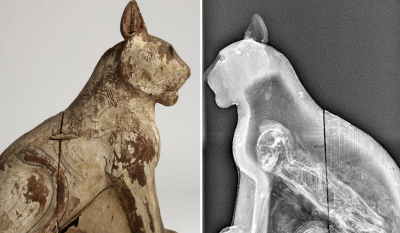
The Egyptian pantheon was especially fond of zoomorphism, with many animals sacred to particular deities—cats to Bastet, ibises and baboons to Thoth, crocodiles to Sobek and Ra, fish to Set, mongoose, shrew and birds to Horus, dogs and jackals to Anubis, serpents and eels to Atum, beetles to Khepera, bulls to Apis.
Cats are depicted in tomb scenes as early as the Old Kingdom (over 4600 years ago) and it is in this context that we first see their domestication. Some tomb scenes show cats sitting below their owner’s chair, giving the sense that at some time they were seen as beloved family pets. In fact, mummified cats are sometimes found buried with, or close to, their owners. Cats were more than likely valued as a form of pest control – they were handy to have around where stores of food were concerned, particularly in homes, granaries and fields, keeping mice and rats at bay.
Not only were cats highly regarded for their everyday uses, but also in the divine realm. The best known of the feline deities was Bastet, who was usually either depicted in the theriomorphic (animal) form of a cat, or the hybrid form of a female body with a cat’s head. Bastet was sometimes depicted as a lioness (in earlier times), or as a woman with the head of a lioness (however this was more often related to the goddess Sekhmet, associated with destruction). Bastet was seen as a more mild and calming version of the ferocious lion. She was most commonly identified as the ‘protector of children’, being associated with female fertility, sexuality, and the protection of infants and pregnant women.
The line between ancient Egyptian deities was often blurred – forms could overlap and some animals resulted in being associated with more than one god or goddess, and vice versa. Other goddesses sometimes took on feline forms, including Mut, Hathor and Tefnut. Although the association was predominantly female, there is one divine male cat often found within religious contexts, as a manifestation of the sun-god Ra. This tom-cat is depicted slaying the serpent god Apophis, who was an embodiment of chaos.
At the ‘Cemetery of Cats’ in Saqqara, northern Egypt, thousands of sacred cat mummies from the Late Period (c. 664–332 BC) were discovered. This was associated with a temple to Bastet. Ancient Egyptians would leave mummified animals (both real and fake) and statuettes as offerings to the cult of the god. These represented the species being offered to (in this instance, the cat), in an attempt to appease the god and seek their favour. Animals were also bred in large numbers specifically for performing these offerings. Interestingly, during the 19th century, cat mummies were exported on a mass scale to Europe, especially here in the United Kingdom, where they were used as fertiliser on the fields.
The domestic cat was not the only powerful feline in ancient Egypt – we also see the presence of big cats such as lions, leopards and cheetahs. Lions were often linked to royalty, as a symbol of kingship. Their grand appearance, strength and ferocity were surely qualities that the Pharaoh would want to emulate. Pharaohs were known to keep lions and other large cats as pets, perhaps not only as a status symbol, but also for their protective qualities, warding off ‘evil’. Lions are also shown being hunted in royal hunting scenes, as a display of the king’s strength to overcome even the most powerful of animals.
Credit : Reading Museum
Picture Credit : Google




